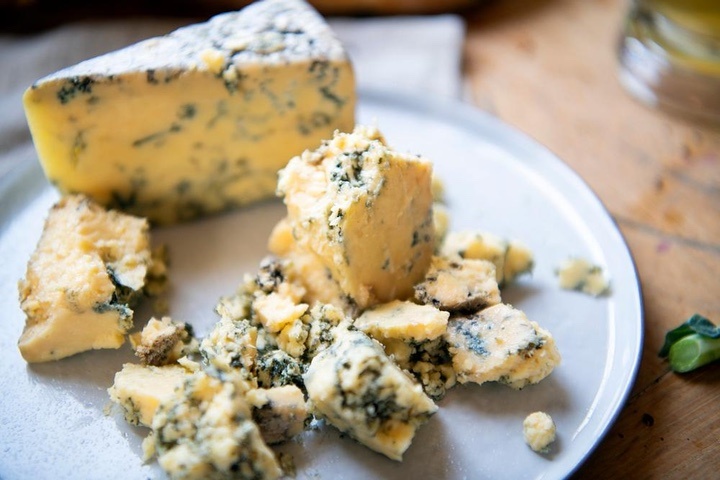Apparently, today is going to be a big day for cheese. Especially, perhaps, for blue cheese.
Today is the day the winners of the “Good Food Awards” will be announced. This is an award that I am not likely to ever receive, even though I’m a pretty darn good cook. The Good Foods Foundation gives these awards to food manufacturers looking for a trophy to place on the CEO’s bookshelf. But also, restaurants and grocery stores that use or sell manufactured foods pay attention to this competition, as do people looking to invest in manufactured foods, so winning this award can meant a big boost to the manufacturer’s bottom line.
But competition, as we all know, can bring out the ugly side of people. I’m thinking of the 1997 boxing match between Mike Tyson and Evander Holyfield. The “Bite Fight”.
In a way, the “Good Foods” awards competition this year turned into its own version of a “Bite Fight”. One of the announced finalists in the cheese category was ‘Climax Blue’, a blue cheese manufactured by Climax Foods in Berkeley, California. (Or, if you prefer the French, ‘fromage bleu’.)
Blue cheese is a general classification of cheeses that have had cultures of the mold Penicillium roqueforti added, and then allowed to sit on a shelf (historically, in a cave with a constant temperature) so that the final product is spotted or veined with blue or blue-gray mold. Undoubtedly, it could be classified as a rotted food.
Problem is, Climax Blue is not cheese. It’s not made from animal milk, but rather a blend of ingredients including pumpkin seeds, lima beans, hemp seeds, coconut fat and cocoa butter.
But it looks like cheese, feels like cheese, smells like cheese, and tastes like cheese. The tasting judges at Good Foods Foundation thought it tasted better than numerous other blue cheese entries in the competition. As my dear old father used to say, if it quacks like a cheese…
After the finalists were announced (but before the winner was announced) somebody-who-will-remain-nameless filed a complaint with the Good Foods Foundation, listing all the reasons why Climax Blue should be disqualified. Including the claim that it’s technically not ‘cheese’.
Many other things are not cheese. For example, American cheese, the kind of non-cheese typically melted atop a cheeseburger. The U.S. Food and Drug Administration has declared that a manufactured food must contain at least 51% actual cheese (made from pressed curds of milk) before it can legally be labeled, “cheese”. The FDA calls it “pasteurized processed American cheese food.” But as a result of the other non-cheese ingredients, American cheese behaves remarkably well when melted over a burger, or inside a grilled cheese sandwich.
To be completely upfront, most grilled cheese sandwiches should be referred to as “grilled pasteurized processed American cheese food sandwiches.”
Like Climax Blue, American cheese was invented in America. Hence, the name. In 1916, a cheese vendor named J.L. Kraft was looking for a way to sell some old cheese, so he ground it up and mixed it with some newer cheese and an emulsifier and various other ingredients, and started the trend that gave us Kraft Singles, Velveeta, and Cheez Whiz.

Something I didn’t realize: Kraft Cheez Whiz doesn’t list “cheese’ as an ingredient.
Ingredients: whey, milk, canola oil, maltodextrin, milk protein concentrate, sodium phosphate, contains less than 2% of modified food starch, salt, lactic acid, whey protein concentrate, mustard flour, Worcestershire sauce (vinegar, molasses, corn syrup, water, salt, caramel color, garlic powder, sugar, spices (contains celery), tamarind, natural flavor), sodium alginate, sorbic acid as a preservative, color added, cheese culture, enzymes, natural flavor.
A typical portion (100 grams, or about 3 ounces) will contribute more than 1600 mg sodium to your diet. This equates to more than 70% of the recommended daily intake.
The ingredients and manufacturing process for Cheez Whiz have changed since the product first hit the market in 1952. Dean Southworth, who was part of the original team that developed Cheez Whiz in the 1950s, described a jar he sampled in 2001 as tasting “like axle grease”. I assume he meant, it tasted “like I imagine axle grease tastes.” But maybe Mr. Southworth had actually tasted axle grease, and could make an accurate comparison.
We have a different problem with Climax Blue, which was disqualified by the Good Foods Foundation from its “Good Food Award” competition, after being originally listed as a finalist on the organization’s website… but also, after the receipt of certain complaints from somebody-who-will-remain-nameless.
All of which has got me thinking about cheese. Especially, about the moldy cheese known as “blue cheese”. You take some milk curds, squeeze out the whey, and then let them sit around at a cool room temperature for three months or more, until they are shot through with mold. Then, declare it a delicacy.
I have to assume Climax Blue, made from lots of ingredients that don’t include “animal milk”, is also allowed to sit around for months, getting moldy.
If only the FDA will change its definition of cheese, from “something that contains at least 51% cheese” to a more friendly definition, like: “something that has sat around getting moldy for at least three months”… then maybe Climax Blue would have a decent chance.
Underrated writer Louis Cannon grew up in the vast American West, although his ex-wife, given the slightest opportunity, will deny that he ever grew up at all. You can read more stories on his Substack account.

